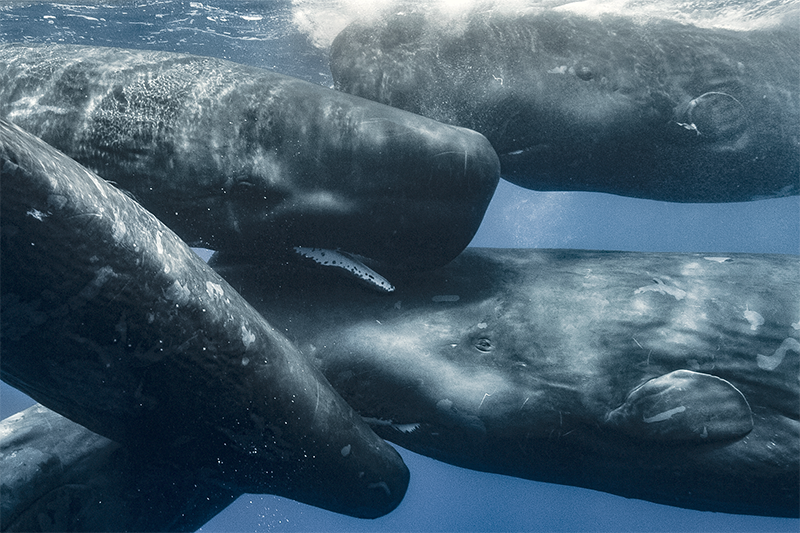

Do Whales Have Culture?
source link: https://nautil.us/do-whales-have-culture-311449/
Go to the source link to view the article. You can view the picture content, updated content and better typesetting reading experience. If the link is broken, please click the button below to view the snapshot at that time.

Do Whales Have Culture?
Sperm whales learn patterns of clicks and other social behaviors from their clans.

The single most familiar image of a sperm whale is still the fierce, ghostly persona of Moby Dick, that albino beast hell-bent on human destruction. The whaling industry prized the sperm whale for its vast quantities of oil, which were used to light lamps, to lubricate machinery, and to fashion into perfumes and potions. Our civilization was fueled by whales for a hundred years, but the animals were never easy to find. The sperms were wary and knew how to elude us. Already in 1835 Thomas Beale, in the first book ever written on the animal, knew that they must have some kind of sophisticated means of communication over great distances, “by which they become apprised of the approach of danger … The mode by which this is effected remains a curious secret.” No human could hear it.
Then scientists began studying their social lives. They realized these great beasts do not sing, but click—quick, rhythmic taps, some quiet, some the loudest sounds we’ve ever known an animal to make. Click. Click. Click. Clicccccreeeeaakkkk. Click. Clickety click [pause] click. Subtle, but exact. The study of these ticking beasts in the world’s deepest waters has led to the greatest question in our journey to understand whales: Do whales have culture?
A recording of a sperm whale known as Physty, who ran aground off Long Island, NY in the 1970s.
During a lifetime a single sperm whale may produce more than half a billion clicks. They make two kinds of clicks: regularly spaced, even ones, whose function is generally believed to be echolocation; and quieter, uneven rhythms, which happen only when the whales are socializing and were originally hypothesized to be signature sounds that identified individual whales. These are called “codas” (even though they don’t always come at the end of something).
In 1981 the World Wildlife Fund decided to support the research of Jonathan Gordon and Hal Whitehead, who started tracking and identifying individual whales off of Sri Lanka on a 33-foot sloop called Tulip, a craft almost the exact length of the average female sperm whale.
Weilgart and Whitehead identified 20 units of sperm whales throughout the South Pacific, which they named “A” through “T.” Different units would associate together to form temporary groups, and each unit could most easily be distinguished by the coda clicks they were making. “As I tabulated the data I was just blown away!” said Whitehead. It made more sense than he expected. Groups of whales that shared the same mother made similar sounds. The kind of click favored by a group could identify its matrilineal family. Weilgart and Whitehead named this the “acoustic clan.”

MIND YOUR MAMA: A single sperm whale can produce more than half a billion clicks during its lifetime. The whales seem to learn their group characteristic clicks from their mothers and their mothers’ relatives. Photo by Wade and Robyn Hughes, from their book Looking for Whales (Halstead Press, 2019).
Tissue sampling showed the whales in any one group shared mitochondrial DNA, suggesting they were related on their mother’s side. But this is not enough genetic similarity to have inherited behavior. Instead, it suggests that sperm whale clicking behavior is indicative of a matrilineal sperm whale society—the whales seem to learn their group characteristic clicks from their mothers and their mothers’ relatives.
Each clan has other distinguishing behaviors besides sound: the regular clan, found in the eastern tropical Pacific and also off of Chile and Ecuador, tended to travel tortuous paths and dive synchronously. The +1 clan, found mostly around the Galapagos, tends to swim more directly, and they do not synchronize their diving.
What are the implications of all this coded behavior? That sperm whales, who learn these clicks at the level of the clan, group, and unit, possess a form of culture. Culture is basically defined as a set of behaviors that are learned by and maintained by a group of animals, independent of or not determined by genetic inheritance. If a pod or clan of whales learns certain ways of living from the others with whom it associates, and maintains those qualities independent of environmental factors, then those attributes are culturally determined.
Whitehead first published his hypothesis in the journal Behavioral and Brain Sciences in 2001, with an article written together with his student Luke Rendell. They suggested that those who study marine mammals might consider their work more like ethnography than zoology, where each population studied is a distinct society with its own unique, defining behaviors—like a tribe. ![]()
Excerpted from Whale Music: Thousand Mile Songs in a Sea of Sound, by David Rothenberg, published in 2023. Published with permission from Terra Nova Press.
Lead photo by Wade and Robyn Hughes, from their book Looking for Whales (Halstead Press, 2019).
-
David Rothenberg
Posted on June 16, 2023
David Rothenberg is a distinguished professor at the New Jersey Institute of Technology, and a musician, philosopher, and author. His books include Nightingales in Berlin, Why Birds Sing, Bug Music, and Survival of the Beautiful. He has performed or recorded music with Pauline Oliveros, Peter Gabriel, Ray Phiri, Suzanne Vega, Scanner, Elliott Sharp, Iva Bittová, and the Karnataka College of Percussion.
Get the Nautilus newsletter
Cutting-edge science, unraveled by the very brightest living thinkers.
Newsletter Signup (Embedded)
Recommend
About Joyk
Aggregate valuable and interesting links.
Joyk means Joy of geeK